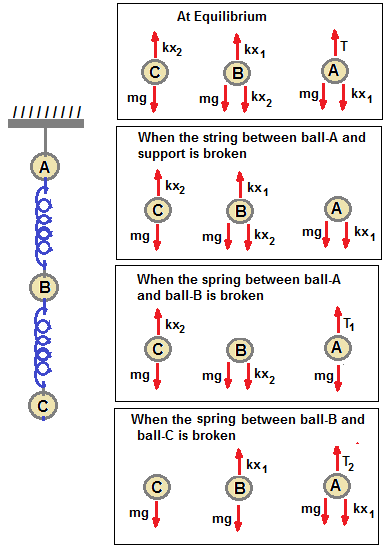Free body diagram for all the cases, i.e., (1) at Equilibrium, (2) When the string between ball-A and support is broken,
(3) When the spring between ball-A and ball-B is broken, and (4) When the spring between ball-B and ball-C is broken are given in figure.
It is assumed that all balls are of same mass m and both springs have same force constant k.
Let x1 be the elongation of spring between A and B. Let x2 be the elongation of spring between B and C.
Let aA, aB and aC are acceleration of balls A, B and C respectively
(1) equilibrium
Let T is the tension in the string between Ball-A and support
for Ball-C :- k×x2 = m×g ..............(1)
for Ball-B :- m×g + k×x2 = k×x1 .................(2)
using eqn.(1), 2×m×g = k×x1 ...................(3)
for Ball-A :- T = m×g + k×x1 .........................(4)
using eqn.(3) T = 3×m×g ........................(5)
(2) When string between ball-A and support is broken
for Ball-A :- m×g + k×x1 = m×aA .............(4)
using eqn.(3), we can rewrite eqn.(4) as , 3×m×g = m×aA , aA = 3×g
for Ball-B :- m×g + k×x2 - k×x1 = m×aB ...................(5)
using eqn.(2), we know that LHS of eqn.(5) is zero, hence aB = 0
for Ball-C:- m×g - k×x2 = m×aC .......................(6)
using eqn.(1), we know that LHS of eqn.(6) is zero, hence aC = 0
(3) When spring between ball-A and ball-B is broken
Let T1 is the tension in the string between Ball-A and support
for Ball-A :- m×g = T1 .............(7)
m×g - T1 = m×aA .............(8)
LHS of eqn.(8) is zero because of eqn.(7), hence aA = 0
for Ball-B :- m×g + k×x2 = m×aB ...................(9)
using eqn.(1), we rewrite eqn.(9) as, 2×m×g = m×aB
Hence aB = 2×g
for Ball-C:- m×g - k×x2 = m×aC .......................(10)
using eqn.(1), we know that LHS of eqn.(6) is zero, hence aC = 0
(3) When spring between ball-B and ball-C is broken
Let T2 is the tension in the string between Ball-A and support
for Ball-A :- m×g + k×x1 = T2 .............(11)
m×g + k×x1 - T2 = m×aA .............(12)
LHS of eqn.(12) is zero because of eqn.(11), hence aA = 0
for Ball-B :- k×x1 - m×g = m×aB ...................(12)
using eqn.(3), we rewrite eqn.(9) as, m×g = m×aB
Hence aB = g (upwards)
for Ball-C:- m×g = m×aC .......................(6)
hence aC = g (downwards)


